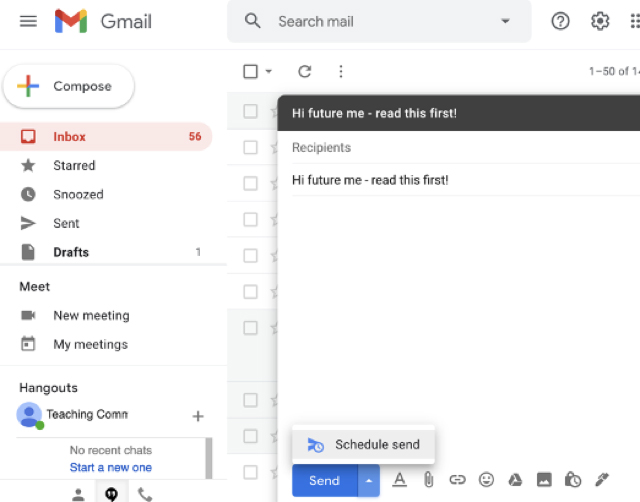The Technique
It is very important in my course that I start building a connection with my learners prior to the first day of the course. I want to bring the life of each learner into the classroom. I want to engage them in practices that nourish their intellectual and creative curiosity as they find their own voice and begin the transition from BScN-prepared RN to MA-prepared Advanced Practice Nurse and/or Primary Health Care Nurse Practitioner.
To honor the complexity of life and who we are as practitioners as well as to respect our individual lived experiences, I write my students a letter prior to the first day of class.* The subject of my letter is the following:
An Invitation to Uncover “My Philosophy of Nursing”
I invite my students (who are already RNs who have developed expertise in their fields) to take a moment before beginning their studies to consider and put into words their “philosophy of nursing.” So often, we don’t fully appreciate the moments of transition in our lives and how the personal and professional are interwoven. I offer the following questions to help ignite their thinking/reflecting:
- What are my beliefs about “being, doing, knowing” nursing?
- What is at the heart of my nursing practice?
- What values are important to me as a nurse, as a human being?
They are free to write without the confines of theory, literature, or APA! Across 2-3 pages, they are free to sort out their thoughts. It is a personal reflection that helps to bridge their professional practice to their academic learning.
The entire course is built upon the belief that the focus of teaching is not delivering content but rather the formation of practice scholars, nurturing the learners’ evolving abilities and capacities to bring theory and philosophy to “serve” their practice. This letter starts that process.
* If there is a large group of students, this can be done as one letter bcc’ing all students.
How I Use It
- I write a letter to each of the students introducing myself and inviting them to join me as “teachers/learners.” In my letter, I ask them to write back a reflective, first-person response that puts into words “My Philosophy of Nursing.”**
- I mail this letter (via email) one week prior to the course start date.
- On the first day of class, the students submit their letters to the D2L Assignments box (digital mailbox).
- I read each letter and write a reply to each learner.
- There are various points of inflection within the course where learners critically explore what philosophical perspectives they are drawn to and why. I ask the students to return to their “My Philosophy of Nursing” to update it.
** This technique is what nurse scholars Gweneth Hartrick Doane and Helen Brown call “Taking the ontological turn.” It’s not for the faint of heart: it commits us, as faculty, to shift our approach from teaching to learning to where [we] teachers and students are all learners — simply human beings, embracing our imperfections, wanting to be better, to do better — each on our unique journey of being well.
Feedback from Learners
As they gain more command over the function of and connection between theory and philosophy, the learners’ personal relationships to particular philosophical and theoretical perspectives deepen/expand. Their understanding of how knowledge practices can illuminate and support them in addressing and strategizing uncertainty in practice becomes more tangible (useful). Some student comments include;
“The other day I found myself actually using intersectionality of all things to map out patient/practitioner concerns, it was like, ‘Whose voice is that?’ — it was mine.”
“I knew when I wrote about my philosophy of nursing that ethics was at the heart of what I do, but as we move forward in class, I have found a philosophical lens that reflects my experience as a nurse. I found a language for it: ‘relational ethics.’”
Supporting goal 3
Ensure healthy lives and promote well-being for all at all ages
Inviting students to map out their “philosophy of nursing” prior to formally engaging in study provides learners with a space of (i) recognition of graduate studies as a space of professional transition and personal growth and (ii) reflection — a safe space for acknowledging the complexity/uncertainties of practice. These expand our abilities as practitioners to support patients/families and communities in meeting their needs towards healthy living and being well.
A short task to challenge you!
In the spirit of making space for our personal beliefs and philosophies, let’s do something to “seed” our 2022 actions: write a letter to your future self which shares one belief that you have that you want to protect/grow in 2022.
Write your letter as though you are telling a dear friend about your plan. Two great questions that you could write about are as follows:
- What is at the heart of my desire to teach and learn?
- What is one value, connected to this desire, that I want to build on in 2022?
1) Open up your Gmail account, and create a new email message. Add a title, and post your letter in the description. Next, add yourself as the Recipient. Don’t send it just yet.
2) How to send what you’ve learned to your future self: Schedule your letter to send on January 1, 2022, by choosing the “More” arrow, next to the “Send” button. 😉

3. OK … now you can click Send!
One Final Task
Is this something you can use in your classroom? How might you utilize it? If you share your results somewhere on social media, link to this lesson for context.


Feedback/Errata